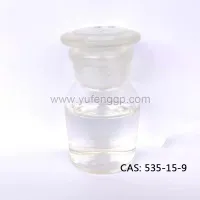Ethyl Dichloroacetate: Properties, Uses, Synthesis, and Safety
Ethyl dichloroacetate is a reactive chemical widely used in organic synthesis and pharmaceutical manufacturing. This guide provides detailed information on its properties, chemical structure, applications, synthesis methods, and safety precautions, designed for chemists, industrial buyers, and researchers.
1. Properties of Ethyl Dichloroacetate
Chemical Formula: C₄H₅Cl₂O₂
Molecular Weight: 147.0 g/mol
Appearance: Colorless to pale yellow liquid
Boiling Point: ~145–147°C
Density: ~1.29 g/cm³
Solubility: Slightly soluble in water; miscible with most organic solvents including ethanol, ether, and chloroform
Reactivity: Contains a dichloroacetate group, making it highly reactive in nucleophilic substitution and esterification reactions.
Ethyl dichloroacetate’s strong electrophilic character makes it a valuable intermediate for chemical and pharmaceutical synthesis.
2. Chemical Structure of Ethyl Dichloroacetate
Structural Formula: Cl₂CHCOOCH₂CH₃
The molecule consists of a dichloromethyl group attached to an acetate ester, which contributes to its reactivity and versatility in chemical transformations.
Cl Cl \ / C - COOCH2CH3
This structure allows it to act as a building block in various organic and pharmaceutical syntheses.
3. What Is Ethyl Dichloroacetate Used For?
Ethyl dichloroacetate has several key applications:
Organic Synthesis Intermediate: Widely used in the preparation of esters, amides, and other derivatives.
Pharmaceutical Manufacturing: Serves as a precursor for active pharmaceutical ingredients (APIs), including herbicides and specialty drugs.
Agrochemicals: Used in the production of pesticides and herbicidal compounds.
Laboratory Research: Acts as a reactive reagent for nucleophilic substitution, alkylation, and condensation reactions.
Its high reactivity and dual functionality make it indispensable for industrial and research chemists.
4. Synthesis of Ethyl Dichloroacetate
Ethyl dichloroacetate is typically synthesized via:
Esterification of dichloroacetic acid with ethanol under acidic conditions, producing high-purity ethyl dichloroacetate.
Chlorination of ethyl chloroacetate using appropriate chlorinating agents, carefully controlled to avoid over-chlorination.
Industrial synthesis emphasizes temperature control, inert atmosphere, and careful addition of reagents to maximize yield and minimize hazardous by-products.
This compound is valued for its efficient incorporation into pharmaceuticals and agrochemical intermediates.
5. Ethyl Dichloroacetate Safety Precautions
Handling ethyl dichloroacetate requires strict safety measures:
Personal Protective Equipment (PPE): Use gloves, goggles, and protective clothing.
Ventilation: Work in a well-ventilated area or fume hood to prevent inhalation.
Avoid Contact: Can cause skin and eye irritation; inhalation may lead to respiratory discomfort.
Storage: Keep in a cool, dry place away from strong bases, oxidizers, and heat sources.
Emergency Measures:
Skin Contact: Rinse with plenty of water; remove contaminated clothing.
Eye Contact: Flush with water for at least 15 minutes; seek medical attention.
Inhalation: Move to fresh air; seek medical help if symptoms persist.
Ingestion: Do not induce vomiting; obtain immediate medical care.
Proper handling ensures safe use in laboratories and industrial settings, minimizing exposure risks.
Conclusion
Ethyl dichloroacetate is a highly reactive and versatile chemical intermediate widely used in organic synthesis, pharmaceutical manufacturing, and agrochemical production. Understanding its properties, chemical structure, applications, synthesis, and safety precautions is essential for chemists, industrial buyers, and researchers to ensure efficient, safe, and regulatory-compliant use.



